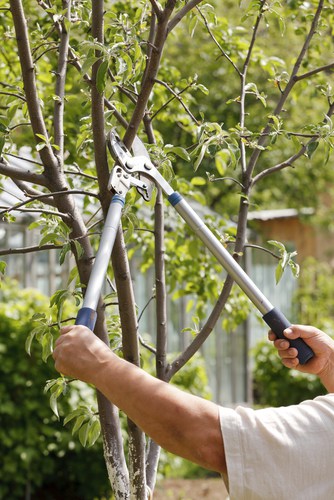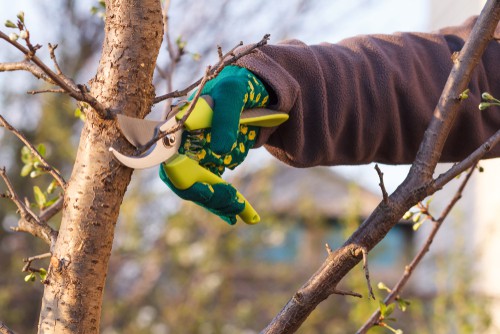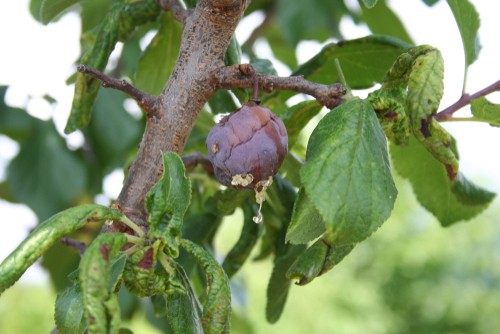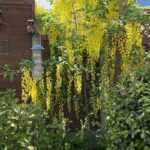Last updated on February 26th, 2022
Our site is reader supported, this means we may earn a small commission from Amazon and other affiliates when you buy through links on our site.
If you have a plum tree then a common question you might find yourself asking is ‘When should I prune?’ And the answer usually lies in knowing what your goals are for the tree. In general, newly planted plum trees that are 1-2 years old should be pruned to encourage them to bush out and form a well-branched tree, and established trees should be pruned to control the size, encourage higher yields and remove damaged or diseased branches. Pruning should be done in spring just before buds appear to reduce the risk of silver leaf disease.

When do you prune plum trees?
If you have a young, small plum tree and you want to grow it quickly so that it produces a stronger harvest, you are better off pruning in the early spring to encourage more vigorous growth.
However, if you have a plum tree that has grown too large that you are unable to harvest, then summer pruning might be the better option for you. If you prune your fruit tree during the summer it reduces the size by cutting off many of the branches without simultaneously encouraging new growth. And you can cut off up to 25% per year.
Of course, there are smaller considerations that you must mull over, such as whether or not your plum tree is diseased, has broken branches or is producing poor quality fruit etc.
Why Timing Matters
It’s important to understand the seasonal cycle of energy that your plum tree has in order to understand when to prune and why timing is important. Timing in the late winter early spring spurns better growth while timing in the summer does not. Why is this? Fruit trees grow much faster if they have ample energy in the spring and their growth slows down during the summer months.
Autumn Pruning
It is not recommended to prune in the autumn because this is the time when your tree does most of its photosynthesis. During the summer your tree is able to convert the light from the sun into sugars and store those sugars into its leaves but as the weather starts to cool and autumn arrives, your tree is preparing for dormancy and to do that it has to move those sugars from the leaves down into the roots.
If you cut and prune in the autumn you run the serious risk of cutting off the branches with the leaves storing the energy that is necessary for the roots. If that happens and the energy doesn’t reach the roots your tree may be unable to support itself. Simultaneously, if you live in a cold climate during the autumn your tree won’t have the energy to heal its wounds caused during the pruning process.

Winter Pruning
During the winter your tree goes into dormancy. The tree itself hardly grows above ground but the roots continue to grow below. A great deal of the energy amassed during the summer and autumn is stored in the root system. If you live in a colder climate this is the perfect time to cut your tree because it won’t have fruit, flowers or leaves on it, so you’ll be able to see the structure of your tree. Doing it at the end of winter is better than the beginning of winter because it allows your tree to heal from any cuts. Moreover, it also spurs more vigorous growth in the coming year because you are selecting only the best branches to produce fruit and you are removing any lower-quality branches.
Your tree has a restricted amount of energy in it and now that energy can be put into a select number of branches that are strong and healthy rather than every single branch, some of which are healthy and some of which are not.
Spring Pruning
As the spring emerges and the weather gets warmer your tree awakens from its dormancy. The energy stored during the winter gets used to power its new growth. This is a favourable time to just take a look at your tree and prune any branches that simply didn’t survive the winter. This will not encourage as much growth because if you prune at the end of winter some of that stored energy has already been used, however, if you want to make your plum tree more compact this is the perfect time to do it.
Summer Pruning
Summer pruning will allow you to reduce the size of a much larger plum tree, giving you the perfect opportunity to remove any crisscrossed branches, broken branches or diseased branches. Pruning during this time will allow you to remove the branches without encouraging new growth and this will give your plum tree the time it needs to rebuild its stockpile of nutrients (through photosynthesis) and drive them back down towards the roots for the winter.
Pruning diseased plum trees

If your plum tree is showing signs of disease you can prune it anytime, don’t wait, remove them as soon as possible. Winter is typically the easiest season in which to notice any diseases and if you choose to wait until the end of winter to cut away the diseased branches it will help your tree to heal quickly. However there is the risk that some diseases are dormant in the winter and if you notice serious diseases like black knot or fire blight, you don’t want them spreading within the tree or to nearby trees so you will need to prune immediately regardless of the season.
How to prune plum trees
Pruning is essential to the health and longevity of your tree but you need to make sure you do it at the appropriate time and this is just as important as doing it correctly. If you don’t prune your plum tree correctly you can actually hurt it. You will need a sharp set of loppers and possibly a pruning saw depending on the size of your tree. If your tree is quite large you will need a sturdy ladder so that you can climb up and reach the top branches.
You can cut off about 25% of the tree each year if it is large and mature and this will help to keep it smaller and contained without doing any damage. Otherwise, you can cut away the sick and dying branches, any branches that are rubbing against one another and preventing proper airflow, and those that you have noticed are already hanging too low before you even consider the added weight of the fruit. We also recommend pruning off any branches that didn’t produce any fruit during the current season.


